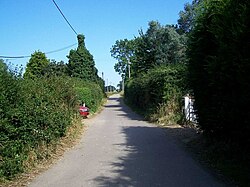Difference between revisions of "Flixton, Lothingland"
(Created page with "{{Infobox town |name=Flixton |county=Suffolk |picture=Track To Old Hall, Oulton - geograph.org.uk - 910458.jpg |picture caption=Track To Old Hall Farm |os grid ref=TM514957 |l...") |
|||
| Line 16: | Line 16: | ||
|website= | |website= | ||
}} | }} | ||
| − | '''Flixton''' is an area with no identifiable village in the north-east of [[Suffolk]], within the | + | '''Flixton''' is an area with no identifiable village in the north-east of [[Suffolk]], within the northward loop of the [[River Waveney]], which bounds the parish to the west. It is two miles north-east of [[Lowestoft]]. |
The parish is sparsely populated with an estimated population of around 40. It borders the parishes of [[Blundeston]], [[Oulton, Suffolk|Oulton]] and [[Corton, Suffolk|Corton]]. | The parish is sparsely populated with an estimated population of around 40. It borders the parishes of [[Blundeston]], [[Oulton, Suffolk|Oulton]] and [[Corton, Suffolk|Corton]]. | ||
Latest revision as of 18:35, 18 November 2023
| Flixton | |
| Suffolk | |
|---|---|
 Track To Old Hall Farm | |
| Location | |
| Grid reference: | TM514957 |
| Location: | 52°30’4"N, 1°42’11"E |
| Data | |
| Population: | 40 (2005 est.) |
| Post town: | Lowestoft |
| Postcode: | NR32 |
| Dialling code: | 01502 |
| Local Government | |
| Council: | East Suffolk |
| Parliamentary constituency: |
Waveney |
Flixton is an area with no identifiable village in the north-east of Suffolk, within the northward loop of the River Waveney, which bounds the parish to the west. It is two miles north-east of Lowestoft.
The parish is sparsely populated with an estimated population of around 40. It borders the parishes of Blundeston, Oulton and Corton.
History
Flixton is recorded in the Domesday Book of 1086 as "Flixtuna".[1] The parish church, which was dedicated to St Andrew, was at least partly in ruins by the 16th century and was abandoned after the Great Storm of 1703 blew off the roof. The ecclesiastical parish was combined with Blundeston. Some ruins, which include 12th-century stonework and Roman bricks possibly reused from the nearby fort at Burgh Castle, remain and are protected as a Grade II listed building and a scheduled monument.[2][3][4]
Flixton Decoy
Flixton Decoy, an area of wooded marshland with a lake of 14 acres of open water, is in the west of the parish and within the area of The Broads national park. The lake is believed to have been created as a result of peat digging. It was the site of a duck decoy owned by the Morse family.[5][6]
Marshland at the edge of the floodplain of the River Waveney extends to the Decoy, with the Lowestoft to Norwich railway line running just to the west of the parish boundary. The nearest railway stations are at Somerleyton and Oulton Broad North.
References
- ↑ The Domesday Book Online - Suffolk F-H
- ↑ Knott S St Andrew Flixton, Suffolk Churches. Retrieved 2021-03-09.
- ↑ National Heritage List 1031947: Ruins of Church of St Andrew (Grade II listing)
- ↑ National Heritage List 1031947: St Andrew's Church (remains of) (Scheduled ancient monument entry)
- ↑ Payne-Gallwey R (1886) The book of duck decoys, their construction, management, and history, p.168. London: John van Vorst. (Available online. Retrieved 2021-03-13.)
- ↑ Monument record FTN 005 - Flixton Decoy (Med), Suffolk Heritage Explorer, Suffolk County Council. Retrieved 2021-03-13.